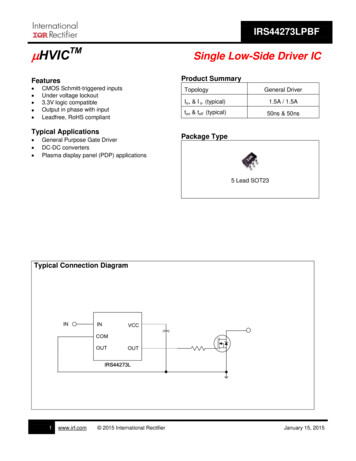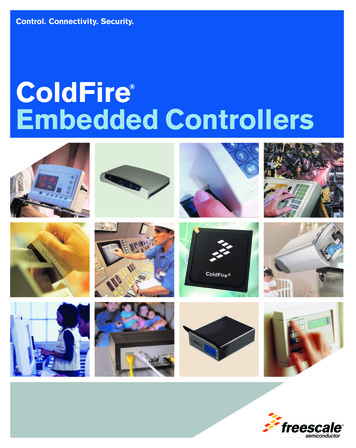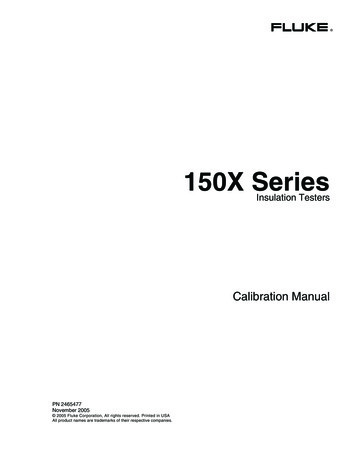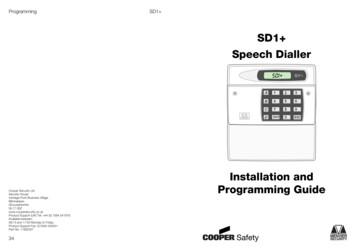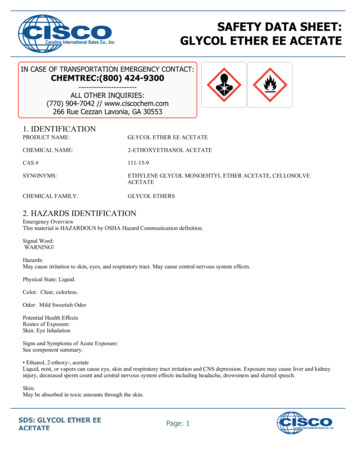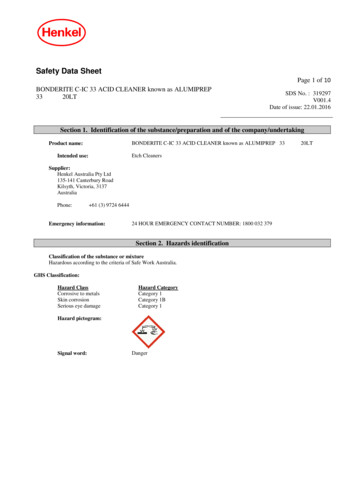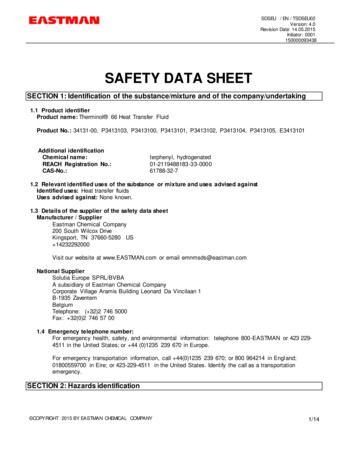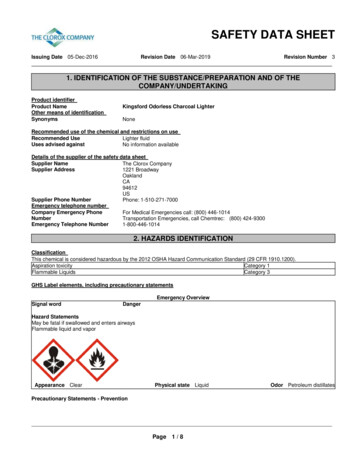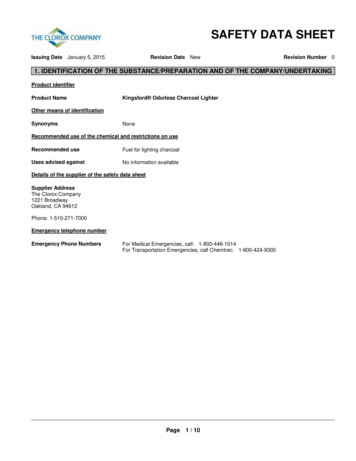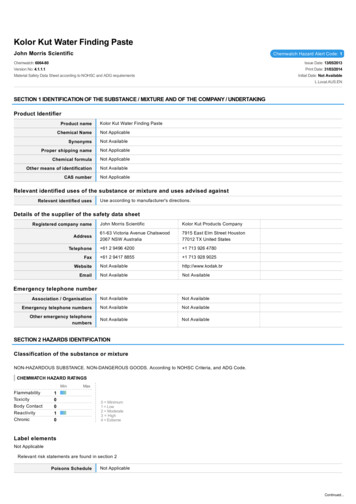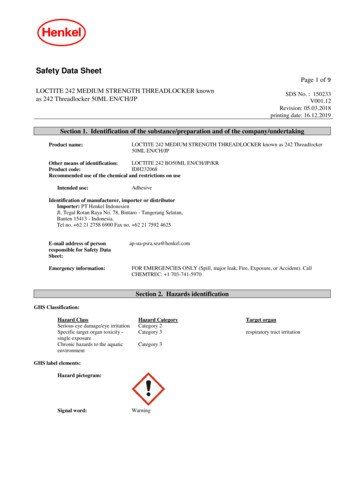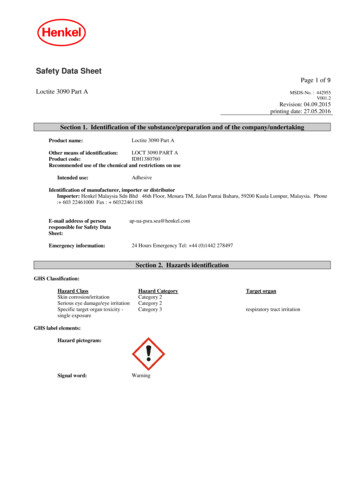
Transcription
Safety Data SheetPage 1 of 9Loctite 3090 Part AMSDS-No. : 442955V001.2Revision: 04.09.2015printing date: 27.05.2016Section 1. Identification of the substance/preparation and of the company/undertakingLoctite 3090 Part AProduct name:LOCT 3090 PART AOther means of identification:IDH1380760Product code:Recommended use of the chemical and restrictions on useAdhesiveIntended use:Identification of manufacturer, importer or distributorImporter: Henkel Malaysia Sdn Bhd 46th Floor, Menara TM, Jalan Pantai Baharu, 59200 Kuala Lumpur, Malaysia. Phone: 603 22461000 Fax : 60322461188E-mail address of personresponsible for Safety DataSheet:ap-ua-psra.sea@henkel.comEmergency information:24 Hours Emergency Tel: 44 (0)1442 278497Section 2. Hazards identificationGHS Classification:Hazard ClassSkin corrosion/irritationSerious eye damage/eye irritationSpecific target organ toxicity single exposureHazard CategoryCategory 2Category 2Category 3GHS label elements:Hazard pictogram:Signal word:WarningTarget organrespiratory tract irritation
MSDS-No.: 442955V001.2Page 2 of 9Loctite 3090 Part AH315 Causes skin irritation.H319 Causes serious eye irritation.H335 May cause respiratory irritation.Hazard statement:Precaution:Prevention:P261 Avoid breathing dust/fume/gas/mist/vapours/spray.P264 Wash hands thoroughly after handling.P280 Wear eye protection/face protection.P280 Wear protective gloves.Response:P302 P352 IF ON SKIN: Wash with plenty of water.P304 P340 P312 IF INHALED: Remove victim to fresh air and keep at rest in a positioncomfortable for breathing. Call a POISON CENTER or physician if you feel unwell.P305 P351 P338 IF IN EYES: Rinse cautiously with water for several minutes. Removecontact lenses, if present and easy to do. Continue rinsing.P333 P313 If skin irritation or rash occurs: Get medical advice/attention.P337 P313 If eye irritation persists: Get medical advice/attention.P362 P364 Take off contaminated clothing and wash it before reuse.Storage:P403 P233 Store in a well-ventilated place. Keep container tightly closed.Disposal:P501 Dispose of contents/container to an appropriate treatment and disposal facility inaccordance with applicable laws and regulations, and product characteristics at time ofdisposal.Section 3. Composition / information on ingredientsSubstance or Mixture:MixtureDeclaration of hazardous chemical:Hazard component CAS-No.Ethyl 2-cyanoacrylate7085-85-0Content60- 100 119-47-10.1- 1 %Hydroquinone123-31-9 0.1 %GHS ClassificationSkin corrosion/irritation 2H315Serious eye damage/eye irritation 2H319Specific target organ toxicity - single exposure 3H335Toxic to reproduction 2H361fChronic hazards to the aquatic environment 4H413Acute toxicity 4; OralH302Serious eye damage/eye irritation 1H318Skin sensitizer 1H317Germ cell mutagenicity 2H341Carcinogenicity 2H351Acute hazards to the aquatic environment 1H400Chronic hazards to the aquatic environment 1H410
MSDS-No.: 442955V001.2Loctite 3090 Part APage 3 of 9Section 4. First aid measuresInhalation:Move to fresh air, consult doctor if complaint persists.Skin contact:Do not pull bonded skin apart. It may be gently peeled apart using a blunt object such as aspoon, preferably after soaking in warm soapy water.Cyanoacrylates give off heat on solidification. In rare cases a large drop will generateenough heat to cause a burn.Burns should be treated normally after the adhesive has been removed from the skin.If lips are accidentally stuck together apply warm water to the lips and encouragemaximum wetting and pressure from saliva inside the mouth.Peel or roll lips apart. Do not try to pull the lips apart with direct opposing action.Eye contact:If the eye is bonded closed, release eyelashes with warm water by covering with wet pad.Cyanoacrylate will bond to eye protein and will cause periods of weeping which will helpto debond the adhesive.Keep eye covered until debonding is complete, usually within 1-3 days.Do not force eye open. Medical advice should be sought in case solid particles ofcyanoacrylate trapped behind the eyelid cause any abrasive damage.Ingestion:Ensure that breathing passages are not obstructed. The product will polymeriseimmediately in the mouth making it almost impossible to swallow. Saliva will slowlyseparate the solidified product from the mouth (several hours).Indication of immediate medicalattention and special treatmentneeded:See section: Description of first aid measuresSection 5. Fire fighting measuresSuitable extinguishing media:Foam, extinguishing powder, carbon dioxide.Fine water sprayImproper extinguishing media:None knownSpecific hazards arising from thechemical:In the event of a fire, carbon monoxide (CO) and carbon dioxide (CO2) can be released.In case of fire, keep containers cool with water spray.Special protection equipment andprecautions for firefighters:Fire fighters should wear positive pressure self-contained breathing apparatus (SCBA).Hazardous combustion products:Oxides of carbon, oxides of nitrogen, irritating organic vapors.Section 6. Accidental release measuresPersonal precautions:Ensure adequate ventilation.Environmental precautions:Do not let product enter drains.Clean-up methods:Do not use cloths for mopping up. Flood with water to complete polymerization andscrape off the floor. Cured material can be disposed of as non-hazardous waste.Section 7. Handling and storageHandling:Ventilation (low level) is recommended when using large volumesUse of dispensing equipment is recommended to minimise the risk of skin or eye contact
MSDS-No.: 442955V001.2Storage:Page 4 of 9Loctite 3090 Part AFor optimum shelf life store in original containers under refrigerated conditions at 2 - 8 C(35.6 - 46.4 F)Section 8. Exposure controls / personal protectionComponents with specific control parameters for workplace:ETHYL CYANOACRYLATE7085-85-0ETHYL NONE123-31-9Value typeTime Weighted Average (TWA):ppmRemarksValue type0.2ACGIHTime Weighted Average (TWA):ppmRemarksValue type0.2MY OELTime Weighted Average (TWA):mg/m3RemarksValue type1ACGIHTime Weighted Average (TWA):mg/m3Remarks2MY OELRespiratory protection:Ensure adequate ventilation.An approved mask or respirator fitted with an organic vapour cartridge should be worn ifthe product is used in a poorly ventilated areaFilter type: AHand protection:Chemical-resistant protective gloves (EN 374).Suitable materials for short-term contact or splashes (recommended: at least protectionindex 2, corresponding to 30 minutes permeation time as per EN 374):nitrile rubber (NBR; 0.4 mm thickness)Suitable materials for longer, direct contact (recommended: protection index 6,corresponding to 480 minutes permeation time as per EN 374):nitrile rubber (NBR; 0.4 mm thickness)This information is based on literature references and on information provided by glovemanufacturers, or is derived by analogy with similar substances. Please note that inpractice the working life of chemical-resistant protective gloves may be considerablyshorter than the permeation time determined in accordance with EN 374 as a result of themany influencing factors (e.g. temperature). If signs of wear and tear are noticed then thegloves should be replaced.Polyethylene or polypropylene gloves are recommended when using large volumes.Do not use PVC, rubber or nylon gloves.Please note that in practice the working life of chemical resistant gloves may beconsiderably reduced as a result of many influencing factors (e.g. temperature). Suitablerisk assessment should be carried out by the end user. If signs of wear and tear are noticedthen the gloves should be replaced.The use of chemical resistant gloves such as Neoprene or Natural Rubber is recommendedEye protection:Wear protective glasses.Hygienic measures:Wash hands before work breaks and after finishing work. Do not eat, drink or smoke whileworking. Good industrial hygiene practices should be observed.Section 9. Physical and chemical properties
MSDS-No.: 442955V001.2Page 5 of 9Loctite 3090 Part AAppearance:Odor:Odor threshold (CA):pH:Melting point / freezing point:Specific gravity:Boiling point:Flash point:Evaporation rate:Flammability (solid, gas):Lower explosive limit:Upper explosive limit:Vapor pressure:Vapor density:Density:Solubility:Partition coefficient: noctanol/water:Auto ignition:Decomposition temperature:Viscosity:VOC content:(2010/75/EC)colourlessLiquidIrritatingNo data available.No data available.No data available.No data available.No data available.80 C (176 F)80 C (176 F)No data available.No data available.No data available.No data available.No data available.No data available.No data available.No data available.No data available.No data available.No data available.No data available. 3%Section 10. Stability and l stability:Conditions to avoid:Hazardous decompositionproducts:Rapid exothermic polymerization will occur in the presence of water, amines, alkalis andalcohols.Stable under recommended storage conditions.Stable under normal conditions of storage and use.None if used for intended purpose.Section 11. Toxicological informationSymptoms of Overexposure:EYE: Irritation, conjunctivitis.SKIN: Redness, inflammation.RESPIRATORY: Irritation, coughing, shortness of breath, chest tightness.Acute oral toxicity:Ethyl Value typeValueSpeciesMethodValue typeValueSpeciesMethodValue typeValueSpeciesMethodLD50 5,000 mg/kgratOECD Guideline 401 (Acute Oral Toxicity)LD50 10,000 mg/kgratLD50367 mg/kgratOECD Guideline 401 (Acute Oral Toxicity)
MSDS-No.: 442955V001.2Page 6 of 9Loctite 3090 Part AAcute dermal toxicity:Ethyl 2-cyanoacrylate7085-85-0Value typeValueSpeciesMethodLD50 2,000 mg/kgrabbitOECD Guideline 402 (Acute Dermal Toxicity)Skin corrosion/irritation:Ethyl 2-cyanoacrylate7085-85-0ResultExposure timeSpeciesMethodslightly irritating24 hrabbitOECD Guideline 404 (Acute Dermal Irritation / Corrosion)ResultExposure timeSpeciesMethodirritating72 hrabbitOECD Guideline 405 (Acute Eye Irritation / Corrosion)Serious eye damage/irritation:Ethyl 2-cyanoacrylate7085-85-0Respiratory or skin sensitization:Ethyl Test typeSpeciesMethodResultTest typeSpeciesMethodnot sensitisingguinea pigsensitisingGuinea pig maximisation testguinea pigGerm cell mutagenicity:Ethyl 2-cyanoacrylate7085-85-0Ethyl 2-cyanoacrylate7085-85-0ResultType of study / Route of administrationMetabolic activation / Exposure timeMethodResultType of study / Route of administrationMetabolic activation / Exposure timeMethodEthyl 2-cyanoacrylate7085-85-0ResultType of study / Route of administrationMetabolic activation / Exposure )methane119-47-1ResultType of study / Route of administrationMetabolic activation / Exposure timeMethodResultType of study / Route of administrationMetabolic activation / Exposure timeMethodHydroquinone123-31-9negativebacterial reverse mutation assay (e.g Ames test)OECD Guideline 471 (Bacterial Reverse Mutation Assay)negativemammalian cell gene mutation assaywith and withoutOECD Guideline 476 (In vitro Mammalian Cell GeneMutation Test)negativein vitro mammalian chromosome aberration testwith and withoutOECD Guideline 473 (In vitro Mammalian ChromosomeAberration Test)negativebacterial reverse mutation assay (e.g Ames test)with and withoutOECD Guideline 471 (Bacterial Reverse Mutation Assay)negativebacterial reverse mutation assay (e.g Ames test)with and withoutEU Method B.13/14 (Mutagenicity)
MSDS-No.: 442955V001.2Page 7 of 9Loctite 3090 Part ARepeated dose toxicity:Hydroquinone123-31-9ResultRoute of applicationExposure time / Frequency of ute of applicationExposure time / Frequency of treatmentSpeciesMethodNOAEL 250 mg/kgoral: gavage14 days5 days/week. 12 dosesratOECD Guideline 407 (Repeated Dose 28-Day OralToxicity in Rodents)LOAEL 500 mg/kgoral: gavage14 days5 days/week. 12 dosesratOECD Guideline 407 (Repeated Dose 28-Day OralToxicity in Rodents)Section 12. Ecological informationGeneral ecological information:Biological and Chemical Oxygen Demands (BOD and COD) are insignificant., Donot empty into drains / surface water / ground henyl)methane119-47-1Value typeValueAcute Toxicity StudyExposure timeSpeciesMethodValue typeValueAcute Toxicity StudyExposure timeSpeciesMethodValue typeValueAcute Toxicity StudyExposure timeSpeciesMethodValue typeValueAcute Toxicity StudyExposure timeSpeciesMethodValue typeValueAcute Toxicity StudyExposure 23-31-9Hydroquinone123-31-9Hydroquinone123-31-9EC 50 10,000 mg/lBacteria3hOECD Guideline 209 (Activated Sludge, Respiration Inhibition Test)LC500.638 mg/lFish96 hOncorhynchus mykissOECD Guideline 203 (Fish, Acute Toxicity Test)EC500.134 mg/lDaphnia48 hDaphnia magnaOECD Guideline 202 (Daphnia sp. Acute Immobilisation Test)EC500.335 mg/lAlgae72 hSelenastrum capricornutum (new name: Pseudokirchnerella subcapitata)OECD Guideline 201 (Alga, Growth Inhibition Test)EC 500.038 mg/lBacteria30 minDIN 38412, part 27 (Bacterial oxygen consumption test)Persistence and degradability:Ethyl -5methylphenyl)methane119-47-1ResultRoute of applicationDegradabilityMethodResultRoute of applicationDegradabilityMethodaerobic57 %OECD Guideline 301 D (Ready Biodegradability: Closed Bottle Test)under test conditions no biodegradation observed0%OECD Guideline 301 F (Ready Biodegradability: Manometric RespirometryTest)
MSDS-No.: 442955V001.2Page 8 of 9Loctite 3090 Part AHydroquinone123-31-9ResultRoute of applicationDegradabilityMethodreadily biodegradableaerobic75 - 81 %EU Method C.4-E (Determination of the "Ready" BiodegradabilityClosedBottle Tes
Method OECD Guideline 401 (Acute Oral Toxicity) MSDS-No.: 442955 V001.2 Loctite 3090 Part A Page 6 of 9 Acute dermal toxicity: Ethyl 2-cyanoacrylate 7085-85-0 Value type LD50 Value 2,000 mg/kg Species rabbit Method OECD Guideline 402 (Acute Dermal Toxicity) Skin corrosion/irritation: Ethyl 2-cyanoacrylate 7085-85-0 Result slightly irritating Exposure time 24 h Species rabbit Method OECD .
